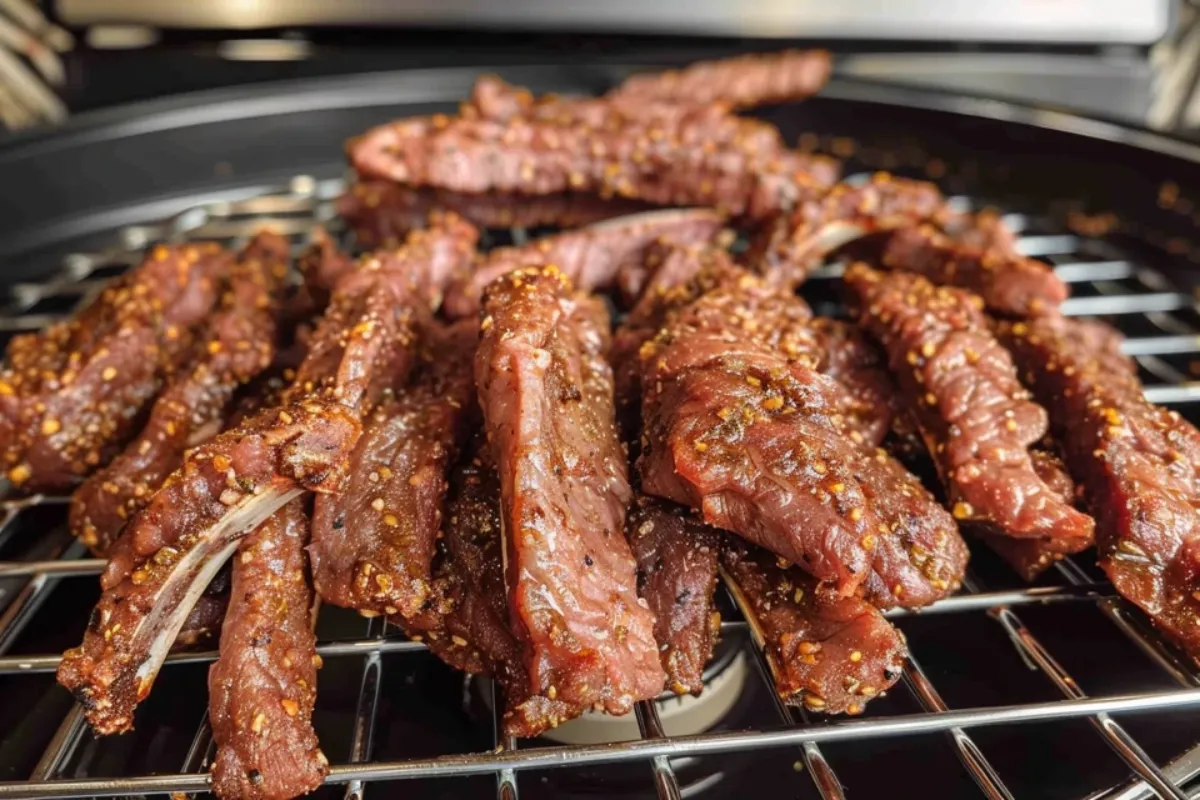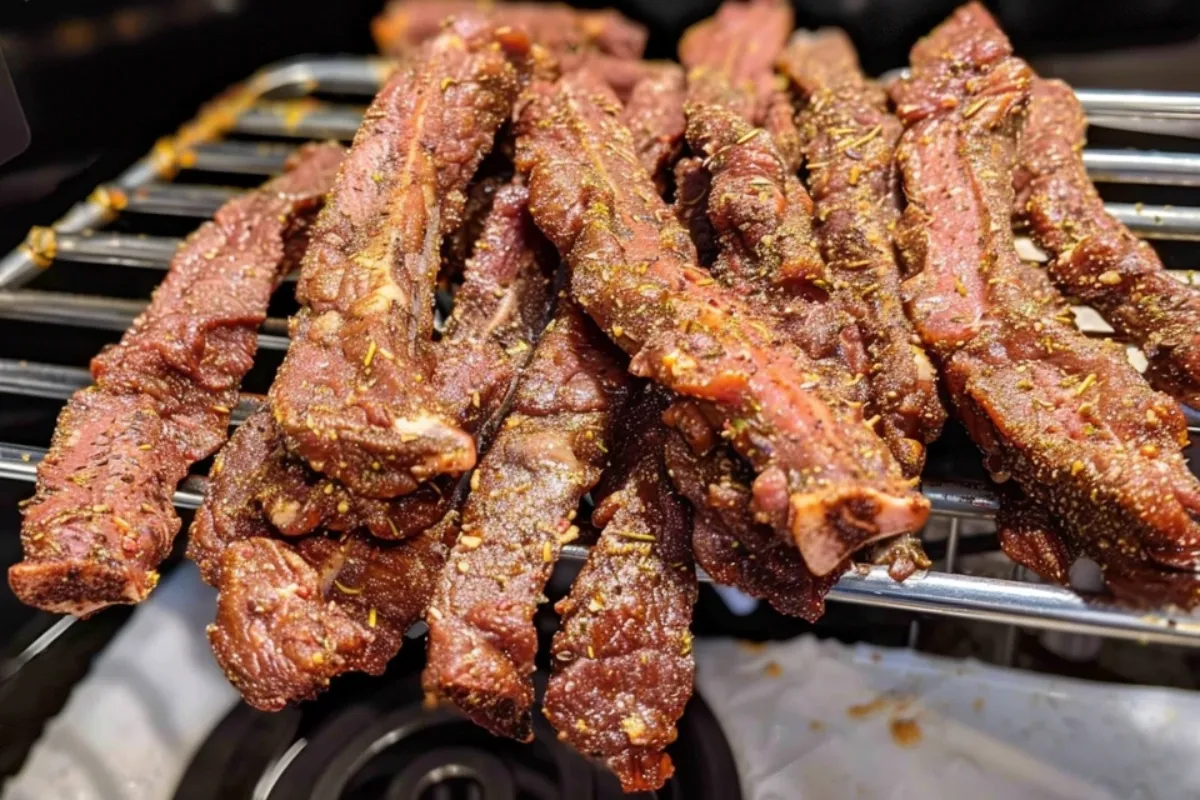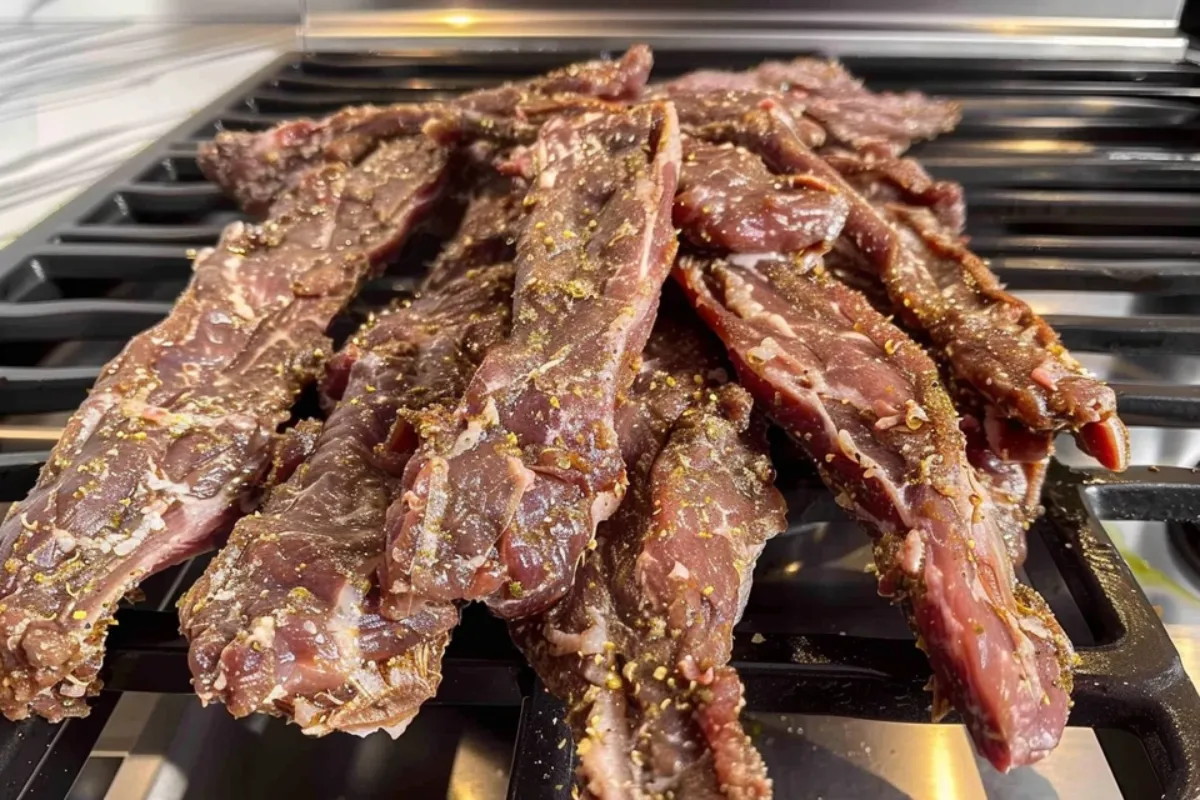Beef finger meat is a flavorful and versatile cut that has gained popularity among culinary enthusiasts. Derived from the spaces between the ribs of cattle, this cut offers a unique texture and rich taste, making it a favorite for various cooking methods.
Introduction
Beef finger meat is a distinctive cut obtained from the intercostal muscles located between the ribs of the cow. Known for its tenderness and robust flavor, it has become a sought-after choice for grilling, braising, and other cooking techniques. Its versatility allows it to be featured in a wide array of dishes, appealing to both home cooks and professional chefs.
1. Understanding Beef Finger Meat
1.1 What is Beef Finger Meat?
Beef finger meat consists of long, thin strips of beef extracted from between the individual ribs in the rib primal section of the cow. These strips, resembling fingers, are known for their rich, beefy flavor and slightly chewy texture. The meat is prized for its depth of taste, often compared to that of short ribs, but with a more accessible price point.
1.2 Origin and Butchering Process
The intercostal muscles, from which beef finger meat is sourced, are located between the ribs and play a role in the cow’s breathing mechanism. During butchering, these muscles are carefully removed to create the distinct finger-like strips. This process requires precision to ensure the meat is separated without excessive fat or connective tissue, resulting in a cut that’s ready for various culinary applications.
2. Nutritional Profile
Beef finger meat offers a substantial nutritional profile, making it a valuable addition to a balanced diet.
2.1 Macronutrients
- Protein: High in protein, beef finger supports muscle growth and repair.
- Fat: Contains a moderate amount of fat, contributing to its rich flavor and juiciness.
- Carbohydrates: Naturally low in carbohydrates, suitable for low-carb diets.
2.2 Vitamins and Minerals
- Iron: Supports oxygen transport in the blood.
- Zinc: Essential for immune function.
- B Vitamins: Aid in energy metabolism and neurological health.
Incorporating beef finger meat into meals can provide these essential nutrients, contributing to overall health and well-being.
3. Selecting Quality Beef Finger Meat
Choosing high-quality beef finger meat is crucial for optimal flavor and texture.
3.1 Visual Indicators
- Color: Look for a bright red hue, indicating freshness.
- Marbling: Fine streaks of fat interspersed within the muscle enhance flavor and tenderness.
3.2 Texture and Smell
- Texture: The meat should feel firm yet slightly yielding to the touch.
- Smell: A clean, neutral scent signifies freshness; any off-odors suggest spoilage.
Purchasing from reputable butchers or trusted markets ensures access to quality cuts.
4. Preparing Beef Finger Meat
4.1 Trimming and Cleaning
- Remove Excess Fat: Trim any large fat deposits to prevent greasiness.
- Eliminate Silver Skin: Use a sharp knife to remove the tough, silvery membrane for improved tenderness.
4.2 Marinating for Flavor
Marinating beef finger can enhance its flavor and tenderness. A simple marinade might include olive oil, garlic, herbs, and acidic components like vinegar or citrus juice to help break down muscle fibers.
5. Cooking Techniques
Beef finger meat’s versatility allows for various cooking methods, each imparting unique flavors and textures.
5.1 Grilling
Grilling beef finger over high heat imparts a smoky flavor and creates a desirable char. It’s essential to monitor the cooking time closely to prevent overcooking, which can lead to toughness.
5.2 Braising
Braising involves slow-cooking the meat in liquid at low temperatures, resulting in tender, flavorful dishes. This method is ideal for breaking down connective tissues, yielding a melt-in-your-mouth texture.
5.3 Stir-Frying
Quickly stir-frying thin slices of beef finger meat with vegetables and sauces creates a balanced and flavorful dish. This technique preserves the meat’s tenderness while allowing it to absorb accompanying flavors.
6. Popular Recipes Featuring
Incorporating this cut into various recipes can showcase its versatility and rich flavor.
6.1 Grilled Skewers
Marinate the meat in soy sauce, garlic, and ginger, then thread onto skewers and grill until charred and cooked through. Serve with steamed rice and grilled vegetables for a complete meal.
6.2 Braised Stew
Slow-cook the meat with root vegetables, beef broth, and herbs until tender and flavorful. This hearty stew is perfect for cooler days and pairs well with crusty bread.
6.3 Stir-Fry
Quickly stir-fry sliced meat with bell peppers, onions, and a savory sauce of soy sauce, oyster sauce, and a touch of sugar. Serve over noodles or rice for a satisfying dish.
7. Cultural Significance and Uses
Beef finger meat holds various cultural significances and is utilized differently across cuisines.
7.1 In Asian Cuisine
In many Asian countries, beef finger meat is prized for its flavor and is commonly used in stir-fries and grilled dishes. Its ability to absorb marinades makes it a favorite in flavorful, saucy preparations.
7.2 In Western Cuisine
Western cuisines often feature beef finger meat in barbecues and stews, where slow cooking methods tenderize the meat and enhance its rich flavor.
8. Purchasing and Storage
Proper purchasing and storage practices ensure the quality and safety of beef finger meat.
8.1 Where to Buy Beef Finger Meat
This cut is available in various locations, including:
- Local Butchers: Offering freshly cut, high-quality meat tailored to your specifications.
- Supermarkets: Pre-packaged options can be found in the meat section.
- Specialty Meat Markets: Ideal for sourcing premium-grade cuts with specific characteristics.
- Online Retailers: Convenient for ordering cuts not easily found locally, with frozen or vacuum-sealed options.
8.2 Storage Tips
Proper storage preserves the freshness and flavor of beef finger meat. Follow these tips:
- Refrigeration: Store fresh meat in the refrigerator at or below 40°F (4°C) and use within 2-3 days.
- Freezing: Wrap the meat in airtight packaging or vacuum-seal it to prevent freezer burn. Store at 0°F (-18°C) for up to six months.
- Thawing: Use the refrigerator or a cold-water bath to thaw frozen meat safely. Avoid leaving it at room temperature.
9. Tips for Cooking Success
Maximize the potential of beef finger meat with these expert tips:
9.1 Preparing for Even Cooking
- Uniform Cuts: Slice the meat into evenly sized pieces for consistent cooking.
- Room Temperature: Allow the meat to reach room temperature before cooking to ensure even heat distribution.
- Preheating: Always preheat your grill, oven, or pan for the best searing and caramelization.
9.2 Flavor Enhancements
- Season Generously: Use a blend of salt, pepper, and spices to bring out the natural flavors of beef finger meat.
- Resting Period: Let the meat rest for 5-10 minutes after cooking to retain its juices and enhance tenderness.
9.3 Avoid Overcooking
Monitor the cooking process closely. Overcooking can cause beef finger to become dry and tough. Aim for medium-rare to medium doneness for optimal results.
10. Comparing Beef Finger Meat to Similar Cuts
Understanding the differences between beef finger meat and other cuts helps in making informed choices for recipes.
| Cut | Description | Texture | Best Cooking Methods |
|---|---|---|---|
| Beef Finger Meat | Strips from intercostal muscles | Slightly chewy | Grilling, braising, stir-frying |
| Short Ribs | Meat on rib bones or boneless strips | Tender, rich | Braising, grilling |
| Flank Steak | Lean cut from the abdominal area | Firm, fibrous | Grilling, searing |
| Skirt Steak | Long, thin cut from the diaphragm area | Chewy, flavorful | Grilling, marinating |
11. Exploring Variations in International Cuisines
11.1 Korean BBQ
In Korean cuisine, beef finger meat is often marinated in a mixture of soy sauce, sugar, garlic, and sesame oil. It’s then grilled to perfection and served with rice and side dishes such as kimchi and pickled vegetables.
11.2 Tex-Mex Style
In Tex-Mex dishes, beef finger meat can be seasoned with bold spices like chili powder, cumin, and smoked paprika. It’s then grilled or sautéed and used in tacos, fajitas, or burrito fillings.
11.3 Italian Braises
Italian chefs use beef finger meat in hearty braises with tomatoes, red wine, garlic, and herbs. This preparation pairs beautifully with polenta or pasta.
12. Sustainability and Ethical Considerations
12.1 Ethical Sourcing
Purchasing ethically raised beef ensures better quality meat and supports sustainable farming practices. Look for certifications such as:
- Grass-Fed: Ensures cattle were raised on a natural diet.
- Organic: Guarantees no synthetic hormones or antibiotics were used.
- Animal Welfare Approved: Indicates humane treatment of animals.
12.2 Reducing Waste
Utilize all parts of the meat and accompanying trimmings. Leftovers can be repurposed into soups, stews, or sandwiches, minimizing food waste.
13. Common Mistakes to Avoid
13.1 Overmarinating
Excessively long marination times can break down the meat too much, resulting in an unpleasant texture. Stick to recommended times based on the marinade’s acidity.
13.2 Skipping the Rest Period
Failing to let beef finger rest after cooking can lead to loss of juices and reduced tenderness. Always allow resting time for optimal results.
13.3 Overloading the Pan
When pan-searing, overcrowding can cause the meat to steam instead of searing. Cook in batches if necessary to achieve the best results.
By following these guidelines, you’ll master the art of cooking and enjoying beef finger in all its flavorful glory!
14. Pairing Beef Finger Meat with Complementary Sides
The right sides elevate the flavor of beef finger , creating a well-rounded and satisfying meal.
14.1 Classic Pairings
- Mashed Potatoes: Creamy mashed potatoes provide a comforting, rich accompaniment.
- Grilled Vegetables: Bell peppers, zucchini, and asparagus add a smoky, fresh contrast.
- Coleslaw: A tangy coleslaw cuts through the richness of the meat.
14.2 Creative Options
- Herbed Quinoa Salad: Light and refreshing, this adds a healthy balance.
- Roasted Sweet Potatoes: Their natural sweetness complements the savory beef flavors.
- Spicy Rice Pilaf: Infused with spices, this side adds a bold kick.
14.3 Sauces and Condiments
Adding sauces enhances the flavor profile of beef finger meat:
- Chimichurri Sauce: A tangy herb-based sauce that pairs well with grilled meat.
- Barbecue Sauce: Smoky and sweet, it’s ideal for finger foods and casual meals.
- Garlic Aioli: A creamy, garlicky dip that balances the meat’s savory taste.
15. Storage and Leftovers
Proper handling of leftovers ensures they remain safe and delicious for subsequent meals.
15.1 Refrigeration Guidelines
- Store leftover beef finger meat in an airtight container.
- Refrigerate within two hours of cooking to maintain freshness.
- Consume refrigerated leftovers within 3-4 days.
15.2 Reheating Tips
- Microwave: Use a low-power setting to prevent overcooking.
- Stovetop: Reheat gently in a pan with a splash of broth or water to restore moisture.
- Oven: Cover with foil and warm at 300°F (150°C) for even reheating.
15.3 Creative Ways to Repurpose Leftovers
Transform leftover beef finger meat into new dishes:
- Tacos: Shred the meat and serve in soft tortillas with fresh toppings.
- Soups: Add to a hearty vegetable or noodle soup for added protein.
- Sandwiches: Layer slices on crusty bread with cheese and arugula.
16. Health Benefits and Dietary Considerations
16.1 Protein for Muscle Maintenance
Rich in high-quality protein, beef finger meat supports muscle repair and growth, making it an excellent choice for active individuals.
16.2 Iron for Energy
The iron content in beef finger meat helps prevent anemia and boosts energy levels by supporting oxygen transport in the blood.
16.3 Moderation and Balance
While nutritious, beef finger meat is best enjoyed as part of a balanced diet. Pair it with vegetables, whole grains, and healthy fats to create a meal that nourishes the body.
17. Cooking Beef Finger Meat on a Budget
Enjoying beef finger meat doesn’t have to break the bank. Here’s how to make it affordable:
17.1 Buying in Bulk
Purchase larger quantities of beef finger meat to save money. Divide into meal-sized portions and freeze for future use.
17.2 Opting for Sales
Look for discounts or sales at local grocery stores or butcher shops to stock up on this flavorful cut.
17.3 Stretching Portions
Use beef finger meat in recipes that combine it with other ingredients, such as stir-fries or stews, to maximize servings.
Conclusion
Beef finger meat is a tasty and flexible cut that’s great to include in your cooking. Its rich flavor, unique texture, and ability to work with different cooking styles make it a favorite for both professional chefs and home cooks. Whether you grill it, braise it, or stir-fry it, this cut offers plenty of options for creating delicious meals. By choosing good-quality meat, preparing it carefully, and pairing it with tasty sides and sauces, you can turn any meal into something special with beef finger. Try this underrated cut and let it inspire your next meal!
FAQ:
1. What cut is beef finger meat?
Beef finger is made up of thin strips of meat taken from between the bones of beef ribs. It comes from the rib section, located between the bones after the rib roast or ribs are removed. This cut has an uneven shape with small pieces of meat mixed with some fat and connective tissue. It’s not a regular steak or roast but leftover trimmings from the rib area.
2. What is finger meat good for?
Beef finger is very flexible and works well in dishes that need slow cooking, as the fat and tissue soften over time. Here are some common uses:
- Stews and Soups: The fat and tissue add flavor and richness as the meat breaks down while cooking.
- Barbecue: It’s great for grilling or smoking when marinated and cooked slowly to make it tender.
- Tacos and Stir-fries: Once cooked, it can be shredded and used in tacos, wraps, or quick stir-fry dishes.
- Braised Dishes: Cooking it in liquid like stock or wine helps soften the meat and add flavor.
- Bone Broth: Since it comes from near the bones, it’s perfect for making rich, flavorful broths.
3. What is a substitute for beef finger meat?
If beef finger is unavailable, try these simple alternatives:
- Short Ribs: Similar fat content and great for slow-cooking dishes.
- Chuck Roast (Cut into Strips): Fatty and ideal for slow cooking or braising.
- Skirt or Flank Steak: Thin cuts suited for quick cooking, though less fatty.
- Beef Back Ribs or Rib Trimmings: From the same area, offering a similar texture.
4. Is finger meat tender?
Beef finger isn’t very tender when raw because of its fat and connective tissue. However, with the right cooking methods, it becomes soft and flavorful:
- Slow Cooking: Cooking for a few hours at low heat softens the tissue, making it tender.
- Braising: Cooking it in liquid helps break down the tissue and adds flavor.
- Smoking or Grilling (Low and Slow): Cooking it slowly over low heat makes the meat soft while keeping its flavor.
- Pressure Cooking: This method speeds up the tenderizing process and gives excellent results.


